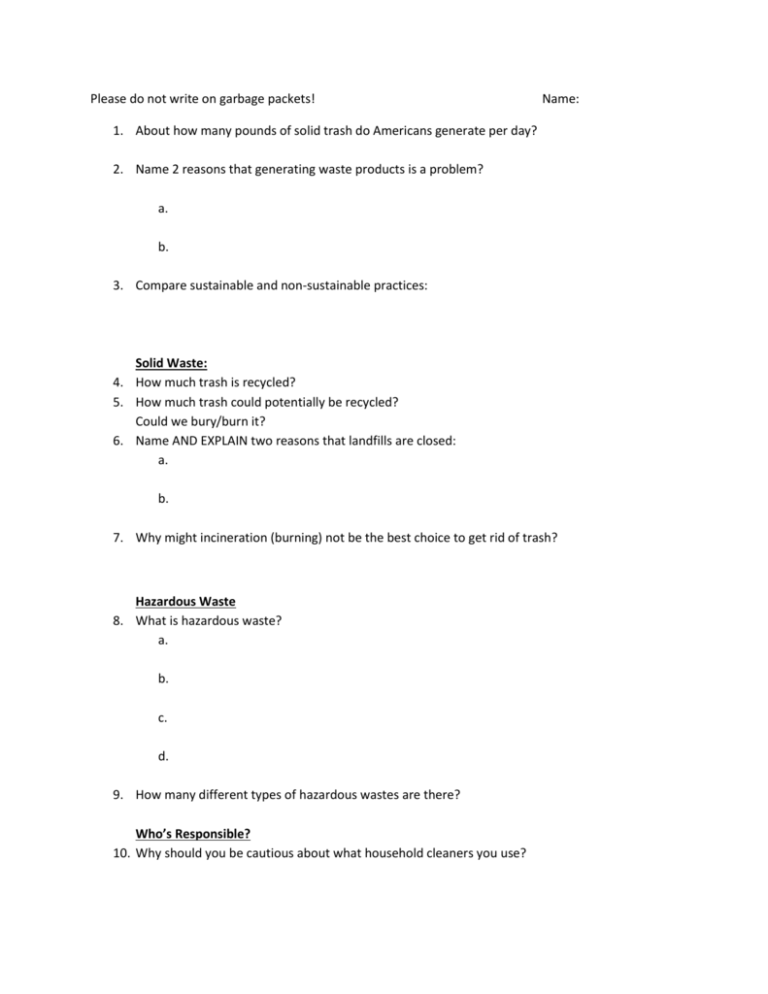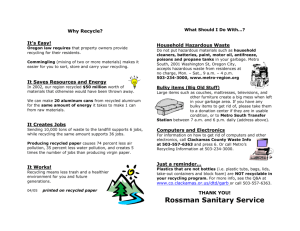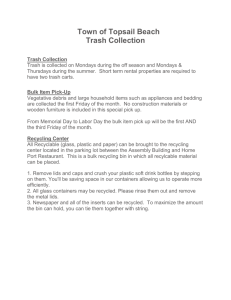Garbage Packets - IHMC Public Cmaps (3)
advertisement

Please do not write on garbage packets! Name: 1. About how many pounds of solid trash do Americans generate per day? 2. Name 2 reasons that generating waste products is a problem? a. b. 3. Compare sustainable and non-sustainable practices: Solid Waste: 4. How much trash is recycled? 5. How much trash could potentially be recycled? Could we bury/burn it? 6. Name AND EXPLAIN two reasons that landfills are closed: a. b. 7. Why might incineration (burning) not be the best choice to get rid of trash? Hazardous Waste 8. What is hazardous waste? a. b. c. d. 9. How many different types of hazardous wastes are there? Who’s Responsible? 10. Why should you be cautious about what household cleaners you use? Sewage/Treating Sewage 11. Where does that wastewater eventually end up? 12. How does the above question relate to the water cycle? 13. What is a natural material that removes waste from sewage? Managing Urban Waste 14. Name at least 3 ways you could reduce waste at home or at school: a. b. c. Graphs (MSW= Material Solid Waste) Figure 1. 15. What is the variable on the Y-axis? 16. What is the variable on the X-axis? 17. About how much MSW was generated in 1960? 18. About how much MSW was generated in 2008? 19. What is the difference in the amount of MSW generated between 1960 and 2008? (use units) 20. In what year was the most MSW generated? Did You Know? Texans dump enough trash every two weeks to fill the Astrodome. Recycling waste materials supports about six times as many waste-related jobs as there would be if the same materials were treated as trash. Yard Trimmings Recycling Facts Throughout a year, at least 20% of solid waste by Texans comes from grass clippings, tree leaves and other landscape waste. Yard debris accounts for approximately 31 million tons of the nation's municipal solid waste. Aluminum Recycling Facts American consumers and industry throw away enough aluminum in a year to rebuild our entire airplane commercial fleet every three months. However, a record 56.85 billion aluminum beverage cans were recycled in the U.S. during 1991 — about 227 cans for every person in the nation. Recycling one aluminum can saves enough electricity to power a TV or a 100watt light bulb for three hours. In 1997, the Recycling Division of the City of Houston Department of Solid Waste Management recycled 20 tons of aluminum cans. Paper Recycling Facts The production of a ton of paper requires 17 trees, 7,000 gallons of water and more energy per ton than glass or steel. Americans dump 180 million tons of garbage annually — more than 40% of which is paper. High-grade printing, copying and writing paper is the largest single component in a landfill. Every year Americans use more than 67 million tons of paper or 580 pounds per person. Americans throw away enough office and writing paper annually to build a wall 12 feet high stretching from Los Angeles to New York. Also, every day American businesses generate enough paper to circle the Earth 20 times. In addition, every year each American household receives an average of 1.5 tree's growth of bulk mail advertising — commonly known as "junk mail." In 1997, the Recycling Division of the City of Houston Department of Solid Waste Management recycled 13,600 tons of paper. Recycling 13,600 tons of paper accounts for the saving of 231,200 trees, 44,880 cubic yards of landfill space and 95,200,000 million gallons of water. Household Hazardous Waste Facts The average American household generates 15 pounds of hazardous waste a year. Most of it goes into landfills, sewage treatment plants and septic tanks. An estimated 1.6 million tons of household hazardous waste exists in the municipal waste stream right now. Fun Facts! The average baby will use about 10,000 diapers before toilet training. An estimated 1 billion trees a year are required to produce disposable diapers. The U.S. Postal Service delivered approximately 63 billion pieces of third-class mail in 1990. An estimated 5 million trees were used to produce all of 1990s third-class mail. An estimated 10 billion pieces of third-class mail were discarded without being opened. 21. Figure 2. How does the amount of MSW from figure 1 compare to the amount of total MSW recycling in 1960?





